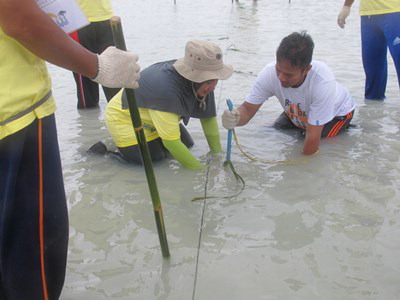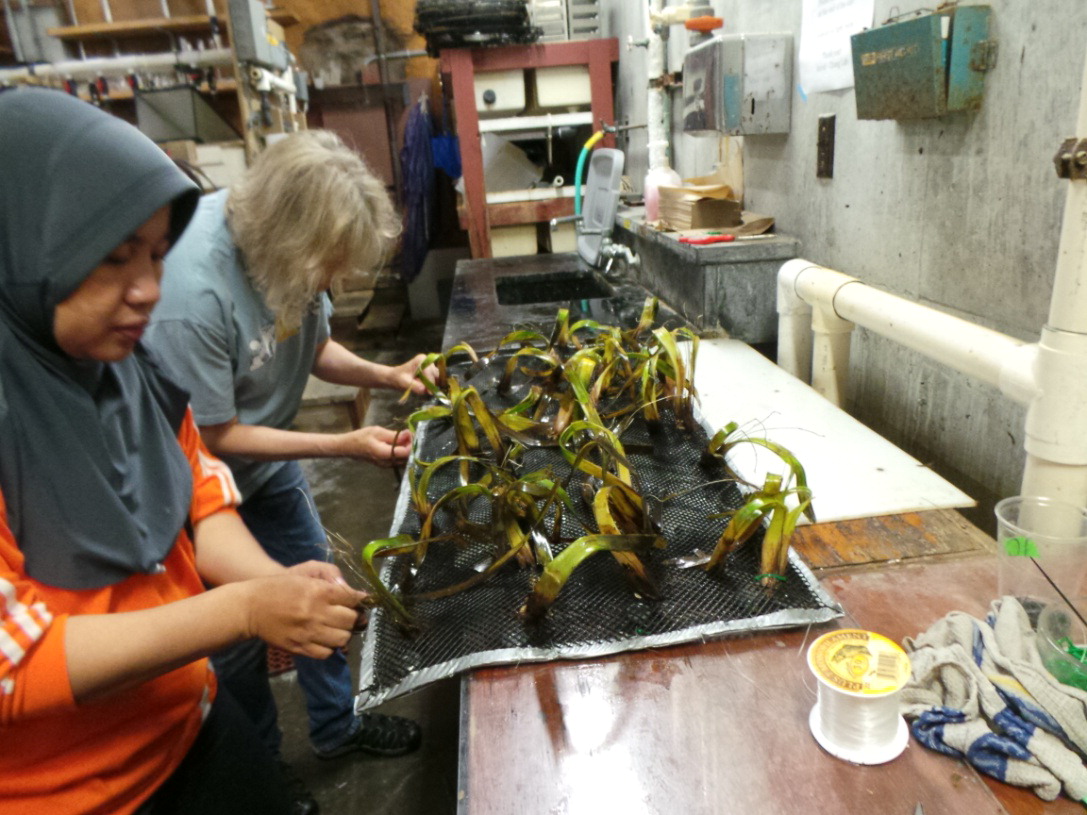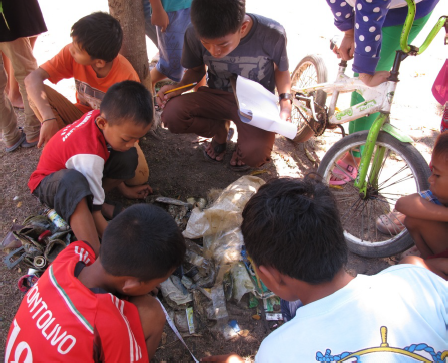Project OverviewSeagrasses are marine flowering plants that form large, shallow, undersea meadows. They are as productive as sugar cane, stabilize shorelines against erosion, and form critical habitat links between land, mangroves, and coral reefs. Seagrass meadows also serve as sinks for trapping excess atmospheric carbon dioxide. Unfortunately, they are declining at rates equal to tropical rain forests and coral reefs. Indonesia is a hot spot for global seagrass diversity; however, the region does not receive the research attention it merits, and seagrass status is poorly documented for Indonesia. This PEER project sought to advance the ecological understanding of seagrass restoration to reverse damage and loss of associated ecosystem functions, such as provision of food, habitat, and nursery areas for diverse marine organisms, including commercially valuable or endangered species such as sea cucumbers (
bêche de mer or trepang), snappers, groupers, dugongs, and sea turtles. Dr. Rohani Ambo-Rappe and her colleagues created a pilot seagrass restoration project by transplanting different combinations of seagrass species to determine which combinations have the best performance in terms of growth, persistence and the diversity and abundance of associated animals. The team also measured the performance of commercially valuable sea cucumber juveniles in the different mixtures of seagrass species.
This research was the first to address the role of different seagrass species in seagrass restoration in the Coral Triangle. While it is generally known that some species facilitate or inhibit the growth of others, the specifics are not known for Indo-Pacific seagrass communities. The knowledge gained helped guide restoration practices and provided new data on the relationship between species diversity and ecosystem function.
 |  |
| Sites on the sea floor are mapped out for the transplantation process (Photo courtesy Dr. Ambo-Rappe) | Dr. Ambo-Rappe (center) transplants the seagrass Enhalus acroroides in the designated site (Photo courtesy Dr. Ambo-Rappe) |
Final Summary of Project Activities
The PI and her team developed seagrass transplantation experimental plots at two project sites in Pulau Badi and Barranglompo, collecting data on different conditions for cultivating seagrass plants and determining the effect of macroalgae coverage on natural and transplanted seagrass beds. The researchers regularly monitored the experimental plots every month, recording data on survival rate, density, and coverage from each treatment, as well as measurements on water quality (light, pH, dissolved oxygen, temperature, salinity, and water current). Among the results from the analyzed data was a positive relationship between seagrass species richness and survivorship of the seagrass transplants and change in coverage. On average, seagrass cover increased only when at least four seagrass species were planted together, with greater results at five species. Change in cover varied for different seagrass species. Half of the species (
Halodule uninervis, Syringodium isoetifolium, Thalassia hemprichii) increased in cover while other species (
Enhalus acoroides, Cymodocea rotundata, Halophila ovalis) lost their cover over time.
Halodule had the highest survivorship and fastest expansion rate. Based on this result, a mixed-species approach holds promise for enhanced seagrass restoration in the tropical Indo-Pacific. The researchers on the PEER team also ran additional experiments on seeding seagrass in different substrates, density of plants providing protection for seedlings, and the effect of macroalga coverage.
The team organized a twice-yearly Marine Debris Census throughout the project period. They trained elementary, junior, and senior high school students to collect and identify the debris, group it into (such as plastic bags, plastic bottles, bottles, cans, wood, leaves, rocks, etc.), and measure the volume of each debris category. From the census data, the team produced a manuscript comparing debris data between Indonesia and the United States. The PEER team held two stakeholder workshops on the importance of seagrass to marine life and about threats to seagrasses in Indonesia. The project contributed to the research of three Master’s degree students and helped create a new Master’s program in Integrated Coastal Resources Management. The PEER researchers received two smaller grants, worth about $20,000 total, from the Directorate of Higher Degree of Indonesia to continue their work, and they presented their results at two international conferences. Dr. Ambo-Rappe also reports that she has been in communication with staff from the Indonesian National Conservation Agency for Sea and Coastal Areas, which has expressed interest in implementing the seagrass restoration method developed under her project in their conservation areas. After the PEER project ended, she planned to develop an action document to guide this collaboration with the agency.
PublicationsRohani Ambo-Rappe. 2022. The success of seagrass restoration using Enhalus acoroides seeds is correlated with substrate and hydrodynamic conditions.
Journal of Environmental Management 310: 114692.
https://doi.org/10.1016/j.jenvman.2022.114692 Nenni Asriani, Rohani Ambo-Rappe, Mahatma Lanuru, Susan L. Williams. 2018.
Botanica Marina 61(3): 205-211.
https://doi.org/10.1515/bot-2017-0127 Mahatma Lanuru, Rohani Ambo-Rappe, Khairul Amri and Susan L. Williams. 2018. Hydrodynamics in Indo-Pacific seagrasses with a focus on short canopies.
Botanica Marina 61(1): 1-8.
https://doi.org/10.1515/bot-2017-0037
R. Ambo-Rappe and C. Rani. 2018. Physical structure of artificial seagrass affects macrozoobenthic community recruitment.
IOP Conference Series: Journal of Physics: Conf. Series 979: 012006.
https://doi.org/10.1088/1742-6596/979/1/012006 Christine Sur, Jessica M. Abbott, Rohani Ambo-Rappe, Nenni Asriani, Sarah O. Hameed, Brittany M. Jellison, Hasriani A. Lestari, Steven R. Limbong, Musdalifah Mandasari, Gabriel Ng, Erin V. Satterthwaite, Sulham Syahid, Dale Trockel, Widyastuti Umar, and Susan L. Williams. 2018. Marine Debris on Small Islands: Insights from an Educational Outreach Program in the Spermonde Archipelago, Indonesia.
Frontiers in Marine Sciences 5:35.
https://doi.org/10.3389/fmars.2018.00035 Susan L. Williams, Rohani Ambo-Rappe, Christine Sur, and Steven R. Limbong. 2017. Species richness accelerates marine ecosystem restoration in the Coral Triangle.
Proceedings of the National Academy of Sciences 114(45): 11986-11991.
https://www.pnas.org/cgi/doi/10.1073/pnas.1707962114 Ilham Antariksa Tasabaramo, Mujizat Kawaroe, and Rohani Ambo Rappe. 2015. Laju pertumbuhan, penutupan, dan tingkat kelangsungan hidup
Enhalus acoroides yang ditransplantasi secara monospesies dan multispesies [Growth rate, cover, and survival rate (
Enhalus acoroides) transplanted in monospecies and multispecies]. J
urnal Ilmu dan Teknologi Kelautan Tropis 7(2): 757-770.
https://doi.org/10.28930/jitkt.v7i2.11169 Susan L. Williams, Jessica Abbott, Grace Ha, and Rohani Ambo-Rappe. 2014. Juvenile batfish hidden in seagrass.
Coral Reefs 33: 909.
https://doi.org/10.1007/s00338-014-1194-6 






